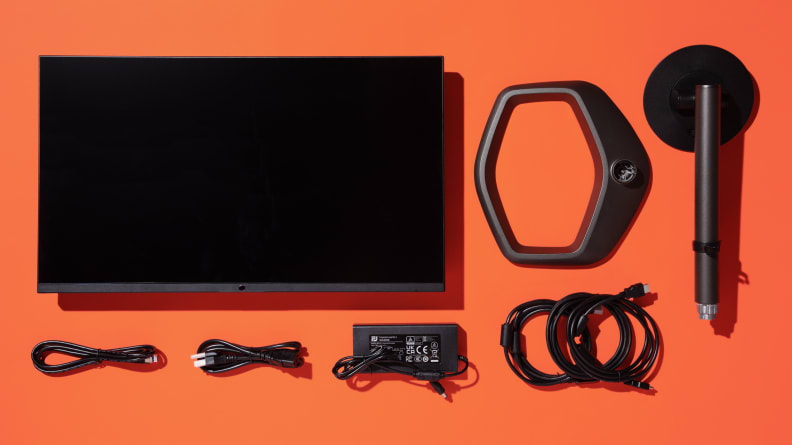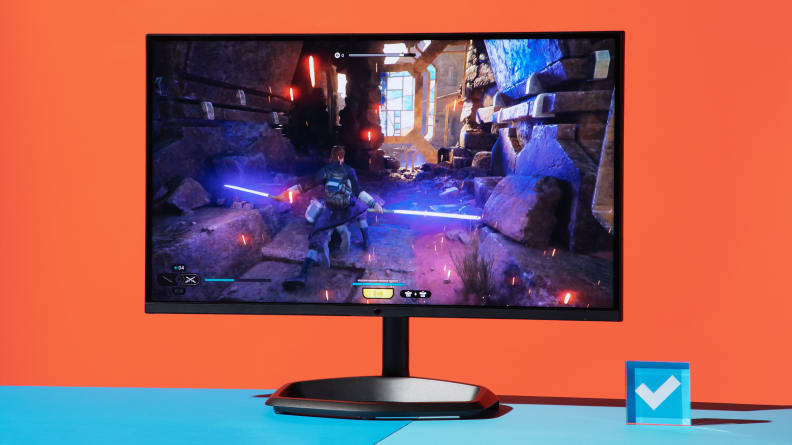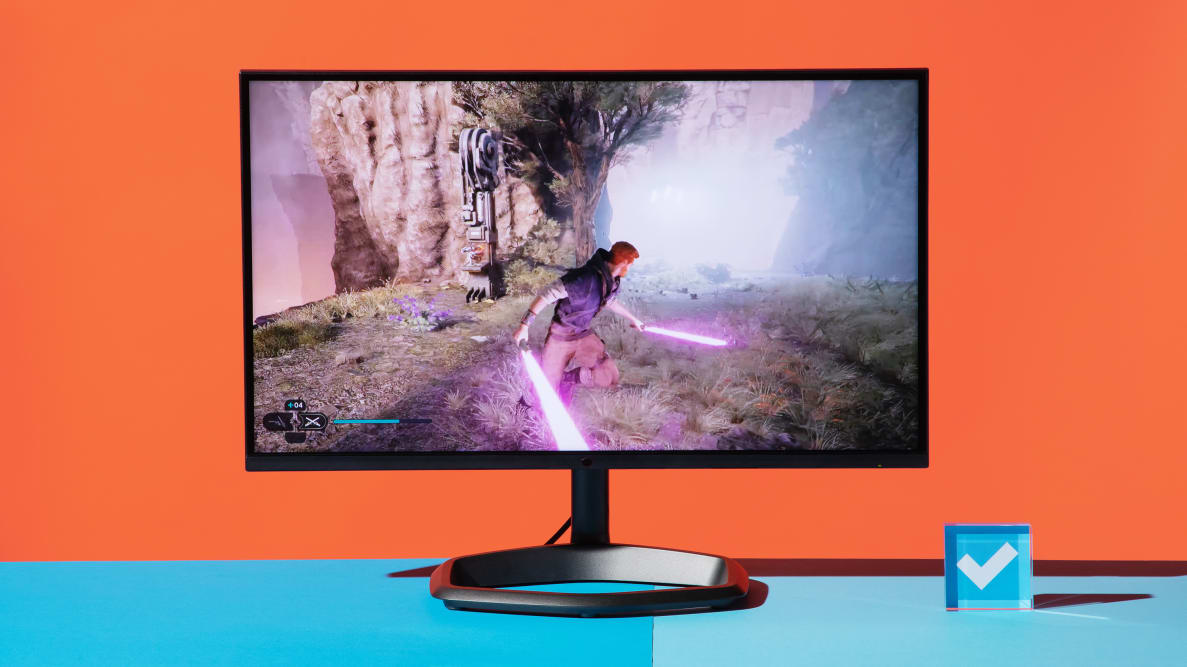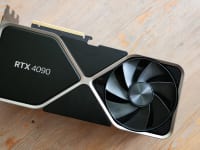Pros
-
Eye-searing HDR
-
Good value
-
Great color accuracy
Cons
-
Luminance stability issues
-
Cooler Master is still working out the bugs
About the Cooler Master Tempest GP27Q

The Cooler Master is a lower-priced, more standard option to consider if you're on the market for a new mini-LED gaming monitor.
Here are the specs of the monitor we tested:
- Price: $530
- Display Size: 27 inches
- Resolution: 2560 x 1440 pixels
- Refresh rate: 165Hz
- Peak brightness: 600 nits (SDR rated), 681.2 nits (SDR tested), 1200 nits (HDR rated) 946.5 nits (HDR tested)
- HDR support: VESA DisplayHDR 1000, HDR10
- Color depth: 10-bit (8-bit + FRC)
- Color saturation: DCI-P3 98% (rated), DCI-P3 96% (tested), AdobeRGB 99% (rated) AdobeRGB 100% (tested)
- Contrast ratio: 1000:1 (rated), 1050:1 (tested SHR with local dimming disabled), 3050:1 (tested SDR with local dimming enabled), 27943:1 (tested HDR with local dimming enabled)
- Pixel response time (GtG): 1ms
- Ports: 1x DisplayPort 1.4, 2x HDMI 2.0, 1x USB-C with 90 watts Power Delivery and DisplayPort Alternate Mode, 1x USB 3.2 Type-B (upstream), 2x USB 3.2 Type-A (downstream)
- VRR Support: Adaptive Sync, AMD FreeSync, Nvidia G-Sync compatible
- Other features: 100mm x 100mm VESA mount, 2x 3-watt speakers, 576 local dimming zones, integrated KVM, Quantum Dots
Cooler Master has priced the Tempest GP27Q at an alluring $530. That’s the lowest price of any monitor that promises VESA DisplayHDR 1000 certification. It feels like a bargain, and it is—if you can put up with its quirks.
The Tempest GP27Q is the more affordable monitor in the Tempest line, as Cooler Master also offers the 4K Tempest GP27U for $830. Apart from the bump in resolution, the Tempest GP27U is otherwise identical to the GP27Q, reaching the same 165Hz refresh rate.
What we like
HDR looks outstanding

This monitor provides excellent contrast in light and dark settings, with help from it's impressive HDR.
The Cooler Master Tempest GP27Q is VESA DisplayHDR 1000 certified and claims a maximum peak brightness of 1200 nits. I measured a maximum sustained HDR brightness of 946.5 nits, which isn’t as bright but is still excellent.
Even some of the best IPS panels without a mini-LED backlight, such as the Sony InZone M9, peak at about 600 nits. OLED monitors like the LG Ultragear 27GR95QE can hit up to 800 nits or more, but can only sustain that level of brightness across a small portion of the display.
Brightness is key to getting good HDR performance, which is designed to provide a wider range of luminance information compared to SDR. HDR can show details in bright areas that look blown out in SDR, such as the subtle gradients surrounding a sunset or lens flare around a flashlight in a dark alley.
The GP27Q’s performance is more than enough to give HDR vibrance and punch. Bright games that make excellent use of HDR, such as Forza Horizon 5, have a hyper-realistic look that leaps off the screen.
And there’s more to this monitor than brightness. The Mini-LED backlight, which includes 576 dimming zones, can dynamically turn off the backlight when portions of the image should be pitch-black. I measured a maximum HDR contrast ratio of 27943:1, which is astounding for IPS, which usually tops out at 1000:1. The monitor can provide a convincing depth to all scenes and looks good when rendering dark, high-contrast content, such as horror and survival games.
The monitor uses Quantum Dot technology to deliver a broad color gamut that covers up to 100% of sRGB and AdobeRGB color gamuts, plus 96% of DCI-P3. That’s an excellent result and competitive with top-tier OLED monitors, such as the Asus ROG Swift OLED PG42UQ and LG UltraGear 27GR95QE.
Games look vivid and present dazzling color. It’s a look that’s well suited to many modern titles, whether it’s the neon-lit streets of Cyberpunk 2077 or the cell-shaded Borderlands 3.
SDR isn’t bad, either

The 2560 x 1440 resolution on the Cooler Master makes this monitor an optimal choice when it comes to streaming and gaming.
The strengths that give this monitor its HDR punch remain useful in SDR. I measured a maximum SDR brightness of 681 nits, which is excellent, and the monitor’s color performance remains impressive.
It’s sharp, too, thanks to the monitor’s 2560 x 1440 resolution. The Cooler Master Tempest GP27Q doesn’t have the ultrasharp look provided by a 27-inch 4K monitor but is still crisp. Games look refined and generally avoid stair-stepping or shimmering issues that can be caused by patterns or highly detailed objects, like stairs or a chain-link fence.
Desktop productivity apps also present good detail in fine fonts and small interface elements. You’ll see pixelation around fonts if you really lean in and look for it, however.
While the monitor’s SDR performance is good, the contrast ratio is restrained. I measured a maximum contrast ratio of 3050:1 with local dimming enabled, and 1050:1 with it off.
That’s much better than a standard IPS monitor like the Acer Nitro XV272U Vbmiiprx, which reached a contrast ratio of just 1120:1, but OLED monitors can easily defeat the GP27Q. The LG UltraGear 27GR95QE, for instance, reached a peak SDR contrast ratio of 14090:1.
I appreciate the GP27Q’s versatility. Though sold as a gaming monitor, its excellent color performance, high brightness, and healthy contrast make it suitable for many tasks. It’s a good choice for digital art, photo editing, video editing, game development, and general productivity.
It’s not the best at any of these tasks, but it can handle all of them at a reasonable price. That’s important for work-from-home gamers who plan to use the same monitor for work and play.
It’s attractive, but functional

The functionality of this monitor's connectivity ports panel isn't lost on us.
The Cooler Master Tempest GP27Q’s design isn’t a stunner, but it’s competent, well-built, and offers practical benefits. Flip the monitor around and you’ll find a reserved but handsome rear panel with a wing-like design that rises towards the top of the monitor.
These “wings” include LED lights which, along with a ring of customizable LEDs in the monitor’s center. The lights can be adjusted for color and brightness or, if you prefer, turned off entirely.
The GP27Q’s stand is sturdy, minimizes display wobble, and uses a compact hexagonal base that takes up minimal space. That last point is the most important. Many other gaming monitors, such as LG’s Ultragear 27GR95QE and AOC’s Agon Pro AG274QZM, use a wide, sweeping stand that takes up unnecessary desk space.
The GP27Q’s connectivity is a win, too. The monitor has two HDMI 2.0 ports, which are limited to a refresh rate of 144Hz, and one DisplayPort 1.4a, which can hit the monitor’s maximum of 165Hz. This is a minor disappointment on paper but not an issue in real-world use.
There’s also a single USB-C port that supports up to 90 watts of Power Delivery and DisplayPort Alternate Mode, so it can be used as a single-cable charging and video input for a USB-C compatible laptop or even the Steam Deck. The USB-C port’s power delivery won’t be enough to handle a gaming laptop, but that’s true of all USB-C monitors currently on the market.
Cooler Master also throws in a pair of bundled speakers. They don’t sound great and most gamers won’t want to use them, but they provide a backup option if your headset is out of reach. They’re also fine for less demanding audio content, such as podcasts.
What we don’t like
Luminance stability is a problem

The Cooler Master's ability to manage brightness between multiple content sources is questionable and dull at times, even with the help of four dynamic backlight modes.
Despite its perks, the Cooler Master Tempest GP27Q has a flaw to consider before hitting the buy button: its luminance stability is rather awful.
Luminance stability is a monitor’s ability to sustain its brightness while displaying a variety of content. It’s not normally an issue because IPS monitors with edge-lit backlights, the most common type, benefit from perfect luminance stability. These monitors don’t change the brightness of the backlight based on what’s displayed.
Mini-LED monitors are different. They constantly alter the level of brightness across the display’s available dimming zones. The goal is for this to happen in a way that’s invisible to the user, but that’s not the case here. The GP27Q offers four dynamic backlight modes (low, medium, fast, and high), and all of them have trouble with maintaining a visually consistent level of brightness over time.
Imagine this: You have a document open in Microsoft Word. It’s a bright, white sheet of virtual paper. But when it’s time for a break, you shift over to YouTube, where you use Dark Mode to reduce distractions and focus on the video. You notice that when you make the switch, everything on the display suddenly looks a bit dim. Even the mouse cursor and the white text, which contrasts against Dark Mode’s dark background, appear dull and muddy.
That’s a luminance stability issue. In fact, the effect can be even more severe. I more than once lost track of the mouse cursor because the luminance variance was so intense that my mouse cursor, which should appear bright and crisp, was barely discernible on a dark background.
This problem is less of an issue in games, which are much less likely to display sudden, extreme swings in brightness. Transitions are usually more gradual, which obscures the problems. On the Windows desktop, however, it’s likely you’ll switch directly between dark and bright apps, and may even need to view them side-by-side. The GP27Q’s Mini-LED backlight can’t handle this common situation.
It’s not as impressive with the dynamic backlight off
The GP27Q’s luminance stability problems can be fixed by turning the dynamic backlight off, but this eliminates half of the perks of mini-LEDs. The contrast ratio drops to 1050:1, which is identical to a monitor with a conventional edge-lit backlight. Using the monitor in this way reintroduces the dreaded “IPS glow,” which casts a hazy gray sheen over dark scenes. It’s a noticeable downgrade.
My workaround for this issue was simple, but annoying. I only use the dynamic backlight while playing games. However, the GP27Q lacks an easy way to toggle this option. Blame Cooler Master’s strange decision to use a rightwards directional press of the joystick, which is located on the back of the monitor, to confirm options instead of pressing in as if it were a button, which is how the menu is opened. To make matters worse, accidentally pressing the joystick down causes the menu to close. I consider it impolite to swear at monitors I have in for review, but I made an exception for the GP27Q.
Motion clarity is fine, but not amazing

Your expectations for speed will ultimately dictate your satisfaction with the 165Hz refresh rate.
A refresh rate of 165Hz at 1440p resolution would’ve been outstanding a few years ago. Today, in 2023, it’s more accurate to call this the price of admission a monitor must pay to slap “gaming monitor” on the box.
Nearly all displays that advertise themselves as “gaming monitors” hit at least 144Hz, and many priced similarly to the GP27Q, like the Gigabyte M27Q X, offer a refresh rate of up to 240Hz.
Motion clarity is strong, with good detail behind fast moving objects and reasonable clarity during fast camera pans in 3D games. For example, character silhouettes and spell effects are legible scrolling across the battlefield in League of Legends. Character names are almost impossible to make out, though, and the tick marks in hitpoint bars aren’t visible. These fine details are noticeable on 240Hz monitors and crisp at 360Hz and above.
How much this matters depends on your expectations. The GP27Q’s motion clarity is enough to satisfy me, but I won’t pretend there’s no difference between this monitor and a 240Hz alternative like the AOC Agon Pro AG274QZM or LG UltraGear 27GR95QE. There is a difference, and it’s significant.
The GP27Q offers support for Adaptive Sync, AMD FreeSync, and Nvidia G-Sync, so adaptive sync features should function with anything you throw at it. I tried it with both AMD Radeon 6000-series and Nvidia RTX 40-Series hardware and found that adaptive sync worked with both.
It feels like an ‘early access’ monitor
Cooler Master has released several firmware updates since the GP27Q’s debut. These add key features, such as the ability to use the dynamic backlight alongside Adaptive Sync, and improve the monitor’s SDR image quality, which suffered from color temperature issues at release. Anyone who decides to buy this monitor should immediately install the latest firmware.
I appreciate Cooler Master’s support, but I can’t help but feel the company released the GP27Q before it was ready. The monitor’s initial out-of-box state wasn’t great, and while the color temperature problem was resolved by new firmware, luminance stability remains much worse than it should be. Cooler Master may eventually release a version of its firmware that resolves all the monitor’s issues—or it may decide the monitor is “good enough” and give up.
Should you buy the Cooler Master Tempest GP27Q?

Considering the reasonable price the Cooler Master Tempest GP27Q is offered at, as well as its overall ability to perform, this gaming monitor is just an "ok" option.
Maybe, if you want good HDR at an extremely low price
The Cooler Master Tempest GP27Q excels at HDR gaming. However, the luminance stability issues and other shortcomings make it feel like an "early access" monitor that was released before it was ready.
This is partially excused by the monitor’s price. Though initially listed for $1,000, the cost quickly dropped to $530 once supply constraints cleared up. That’s a rock-bottom price for a mini-LED monitor that can hit about 1000 nits of brightness. Monitors like the $1,050 AOC Agon Pro AG274QZM or the $1,000 OLED LG UltraGear 27GR95QE deliver impressive HDR image quality without the GP27Q’s flaws, but are leagues more expensive.
The question, then, is whether you can live with the GP27Q’s shortcomings. If you can, or you only plan to play games with HDR enabled, then its price may prove alluring. Just be careful: it won’t feel like a bargain if you get fed up with it after a few months.

The Cooler Master Tempest GP27Q is an affordable gaming monitor that features a decent HDR and brightness with a quick refresh rate to match.
$552.89 at AmazonMeet the tester
Matthew S. Smith is a veteran tech journalist and general-purpose PC hardware nerd. Formerly the Lead Editor of Reviews at Digital Trends, he has over a decade of experience covering PC hardware. Matt often flies the virtual skies in Microsoft Flight Simulator and is on a quest to grow the perfect heirloom tomato.
Checking our work.
Our team is here for one purpose: to help you buy the best stuff and love what you own. Our writers, editors, and lab technicians obsess over the products we cover to make sure you're confident and satisfied. Have a different opinion about something we recommend? Email us and we'll compare notes.
Shoot us an email






